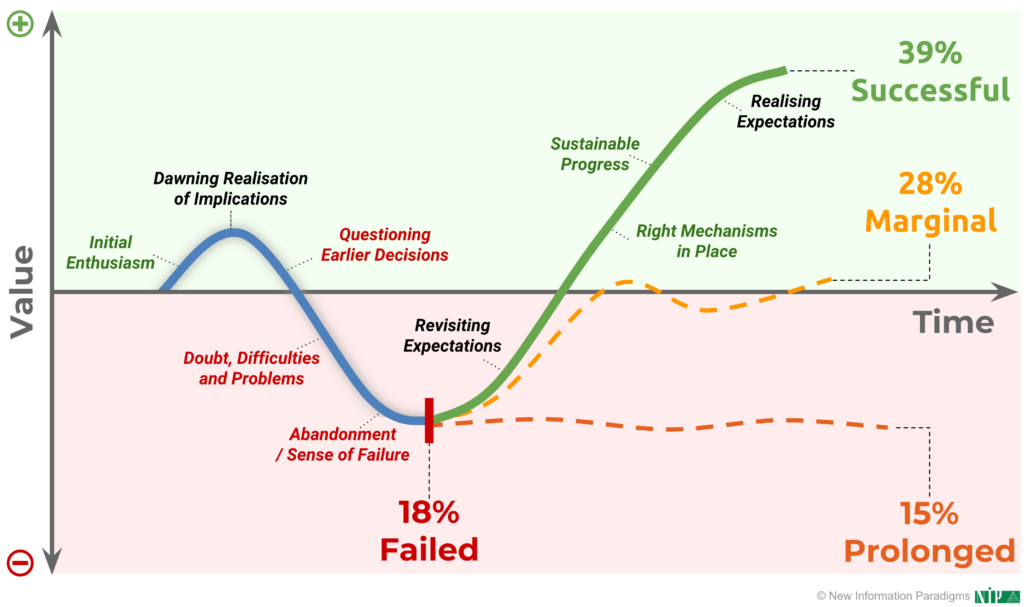The Relationship Issues Diagnostic
Relationships are absolutely critical in successfully navigating today’s Complex, uncertain, volatile and ambiguous commercial environment.
But it’s an understatement that commercial relationships between organizations are in trouble.
As our curve shows, negative and neutral relationship outcomes (61% when adding up 18% failure, 15% prolonged issues and 28% marginal success) are far more likely than positive ones (39% realized expectations):

If anything, front-line feedback suggests that these statistics are conservative, and this all comes with unsustainable waste and cost – both financially, and in human terms.
Unfortunately, none of this gets to the root of what’s going on – the recurring issues behind this unsustainable failure rate – so it prevents responding appropriately and effectively.
The solution
This is where the Relationship Issues Diagnostic comes in, recognizing that an appropriate and effective response means the parties in relationships:
- Understanding and aligning around the Things That Matter.
- Agreeing what needs to be done to turn things around.
- Measuring and managing those activities to their conclusion.
And the first step in this process of getting (back) on track is identifying which issues the parties are facing (or are in danger of being faced with):
- The reality in most relationships is that issues dominate, or at least get in the way of realizing the relationship’s intended Value.
- Clarifying what these issues are – and aligning around what to do about them – is the first step of (re-)building empathy between organizations: the foundation of putting the “Right Mechanisms in Place” on the curve above.
- A catalyst is almost always needed to help the parties in a relationship diffuse any tension, and objectively and constructively identify and align around issues.
Organized into four sections that start with the most immediate front-line experience and work “back” towards more underlying factors, the diagnostic presents 20 of the most prevalent and persistent relationship issues.
Each issue has detailed evaluation statements for consideration, providing a powerful opportunity to accurately take stock of the current state of the relationship.
How It Works
The Relationship Issues Diagnostic is presented in a fully secure online environment, where no technical knowledge is required, and where all information and data is held securely (and not shared with any third party).
Upon submitting their response, each respondent receives a personalized report that presents back and highlights aspects of what they have said.
When all respondents have submitted responses, a more detailed report is generated that synthesizes and analyses all the data to identify:
- Overall trends.
- Specific issues that seem agreed to be problematic.
- Issues with a diverse spread of opinion, suggesting division or perception gaps to resolve – within the parties, between the parties, or both.
- Patterns amongst the issues that have been found.
- Frequent terms used, which can be the beginnings of a shared language.
- Recommended next steps.
Sometimes, an individual might want to trial the diagnostic first, and sometimes a trial group might “pilot” it – in both cases, this is with a view to engaging both parties in the relationship by first considering the perspective of one of the parties (to gain its own insights, to generate evidence for the need to engage, etc).
The Benefits
In all cases, the Relationship Issues Diagnostic will clarify where your thinking is really at – including how aligned (or otherwise) you all are – and establish a benchmark which you can return to later, to track change and evaluate the effectiveness of actions taken.
If you uncover that everything is plain sailing for now, you will have thoroughly substantiated this…
…but more likely is that you will uncover areas of difficulty, where you will have:
- Provided a constructive outlet for clearing the air, surfacing any feelings of powerlessness, voicelessness and frustration, and preparing to reorient around solutions.
- Developed a new way of thinking about the current situation – where previously “subjective” issues can now be considered “objectively” and where specific solutions can be found.
- Engaged a set of people with the “reality” of the relationship – some possibly for the first time, granting you new insights and expertise to access.
- Seen if there are individuals that seem to want to take a lead in understanding and making progress.
- Clarified where to focus, which may include discussing and resolving different perspectives.

